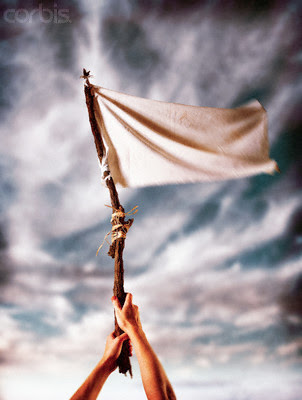Eating Prisoners of War? Ten Thousand Years of ‘I Surrender’ August 29, 2012
Author: Beach Combing | in : Ancient, Contemporary, Medieval, Modern, Prehistoric , trackback***This post is dedicated to A.G. who sent in the following question***
A.G. writes ‘I have often wondered what happened to the wounded left behind during the Napoleonic wars and earlier. Did the locals come along and kill them for their personal belongings, were they cared for and held for ransom, what? I am speaking here of the common soldiers and not their leaders.’ Beach should start by saying that, while no expert, he senses a rich and interesting study here: has anyone tried to reduce this to a book length work: drbeachcombing AT yahoo DOT com
First, let’s establish a range of possibilities if you catch an enemy combatant. To Beach’s mind there are essentially five. (i) You can kill him. (ii) You can keep him as a slave. (iii) You can ransom him. (iv) You can keep him captive until the end of hostilities. (v) You can let him go. Of course, there will be lots of in between categories. (You can avoid killing your prisoner until he is fattened, then you can publicly eat him with the elders of the tribe… some Meso-American cultures.) But these five surely cover the range of possibilities?
So how do these break down historically speaking? Beach suspects the key fact in early human history is that hunter gatherer societies – with their endearing head hunting ways – have little use for slaves: unless we are talking of the let’s-fatten-them-up-before-we eat-them-kind. This corresponds to certain archaeological digs that have happened on early battle scenes where no quarter was given: even to enemy civilians (in as much as that concept existed before there was a civis).
With the beginnings of agriculture and stable settlements and particularly with large scale urban development then slaves make more sense. Warfare starts to be about who you catch as well as what territory as slaves are worth something. Perhaps they will be sacrificed to the gods Mayan style (‘today you die, tomorrow it will be me’), perhaps they will be marched down the main boulevard of Roma in a triumph and then farmed out to a villa to tend vines. The point is that prisoners become a form of currency and kudos.
Ransoming is a more sophisticated version of slavery that demands contact with the enemy. It would be interesting to establish the first systematic ransom culture in history. (Perhaps versions of these can be found in hunter gatherer societies?) The most striking examples here are those extraordinary late medieval wars where knights could not be killed – armour was often so effective. And entire battles could be fought with no fatalities or with one or two from awkward horse falls. Warfare was certainly reduced in Renaissance Italy to a form of rugby scrum and the losers were marched off for after dinner sandwiches in the pavilion where they ate, drank and whored until the money came from home. Very often there were no ‘normal’ soldiers in these tilts.
Thinking of European history modern warfare saw an important new innovation. Slavery was out of question, ransoming and chivalry had passed down into the sewage of time, so what did you do with prisoners… As wars became increasingly ideological – Protestants vs Catholics, Protestants vs Protestants – then widespread killing started up once more: e.g. the Thirty-years War. This was particularly the case when armies had committed atrocities on local populations. The total war vs limited war has to be a major factor in what happens to the enemy when he falls into your lap…
The prisoner-of-war camp is our antidote to the killing fields of early modern Europe. Of course, early on, these prisoner of war camps were so bad that it was just another form of killing. It is enough to think of some of the Napoleonic era camps in the United Kingdom where French prisoners were kept in hulks or on Dartmoor, the prisoner camps in the American Civil War or the shameful concentration camps in Southern Africa during the Boer War. Then by the Second World War you had a new kind of prisoner of war camp where prisoners were encouraged to die not through incompetence or want but as a matter of policy. Of the 110,000 Axis prisoners taken at Stalingrad only about 5 percent made it home. The 95% who did not died of what is politely called privation.
Rereading this and looking again at AG’s question there is a grey area that reaches from 1500 through to 1800 where the fate of ‘normal’ prisoners remains unusually fluid.
***
31 August 2012: Tacitus from Detritus of Empire writes ‘Alas, cannibalism of prisoners persisted to modern times. Many, many reports of this in the Pacific late in WWII. Some combination of plain hunger as the Japanese supply line broke down, perhaps with some mystical “strength of my enemy” overtones. As to the fate of prisoners in the 1500 to 1800 era, at least with sailors a lot of them were just given job offers. If you had reasonable and useful skills you were offered a range of benefits. Death, prison hulk or signing on with a new boss. Since both ships and crew members sometimes switched sides under duress more than once it would have made a 1700s copy of Janes Fighting Ships rather a mess.’ Thanks Tacitus!



